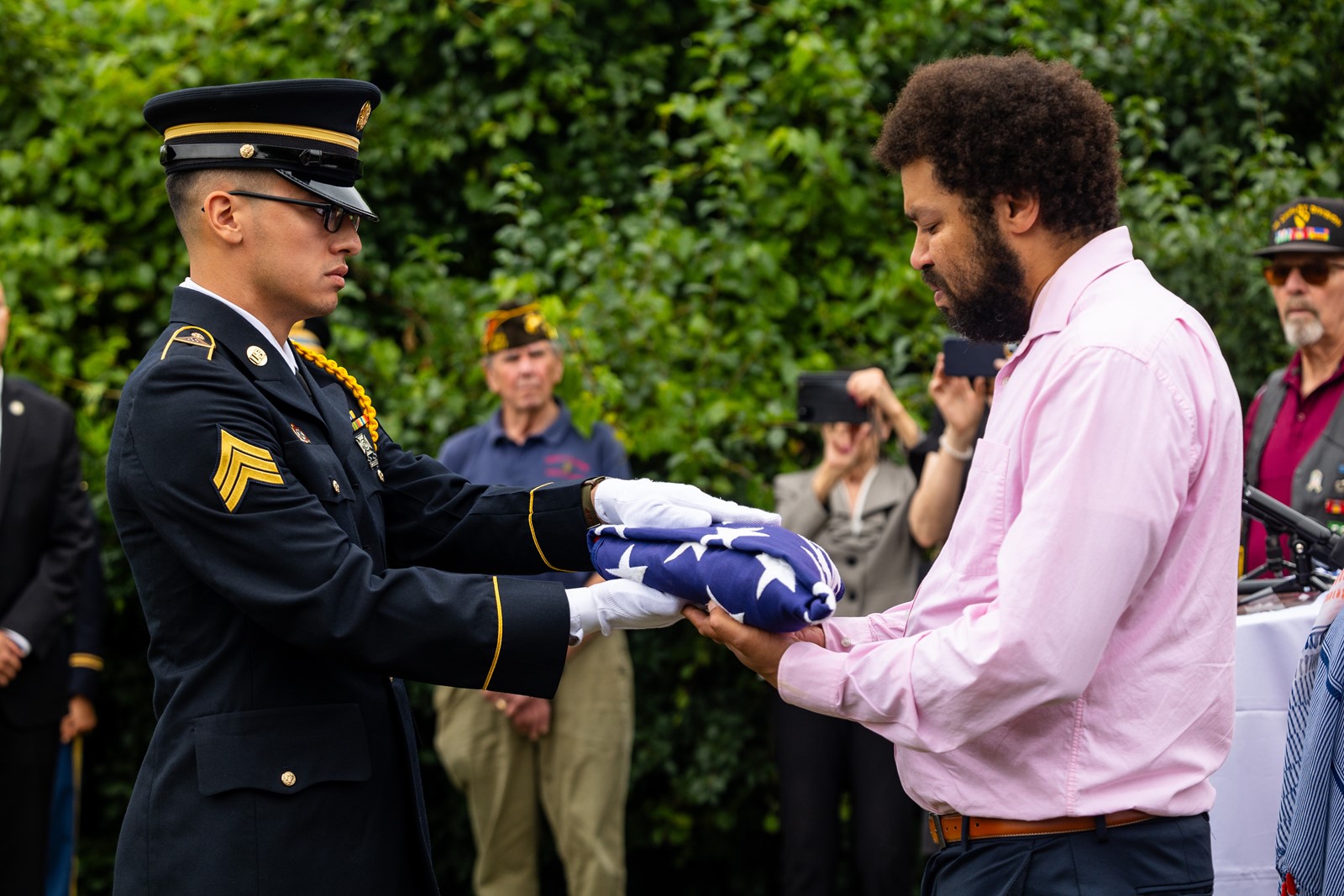
Emilio Aguirre, a World War II combat veteran, died in his apartment in Chicago 30 years ago, not from illness, nor injury. Aguirre died just two weeks before his 82nd birthday from heat as temperatures reached up to what felt like 125 degrees during the 1995 Chicago heat wave.
For nearly three decades, the Army veteran’s death stood lonely, unrecognized and forgotten. Despite being a Bronze Star recipient, there was no formal military funeral, no proper headstone or marker.
That changed last month with a headstone placed at Aguirre’s final resting spot at Homewood Memorial Gardens, where he had been buried with 41 other heat wave victims and other unclaimed or unknown city residents.
And on Thursday, 30 years to the day after his death, Aguirre received full military funeral honors.
“Today , we say your name. Today, we honor your life,” said Kevin Barszcz, director of Chicago’s Mayor’s Office of Veterans Affairs, as he opened Thursday’s service.
Retired Army Capt. Monika Stoy traveled from Washington, D.C., to pay tribute to Aguirre, who had no family at the service.
“I’m going to address him as a family member,” Stoy said, adding his service was filled with fellow veterans — “many extended members.”
Stoy gave a detailed description of Aguirre’s military history, including accounts of his service in the 3rd Infantry division. Along with numerous awards and medals, Story said, he spent six weeks fighting in one of the war’s most difficult battles on January 21, 1944.
Aguirre “survived World War II, a POW camp just to die in a heat wave in Chicago,” she said.
George R. Gandara, a Marine Corps League chaplain and member of the Indigenous Yaqui tribe, conducted a traditional Native American ceremony, offering prayers and blessings to the fallen soldier. This ceremony was “for the soul of Emilio,” he said. Holding an owl wing, where each feather represents a distinct symbol, Gandara wafted scented smoke onto Aguirre’s headstone, his picture and others there to pay their respect.
Barszcz said piecing together Aguirre’s story was an “all hands effort.”
Because Aguirre saved his paperwork, veterans rights activist Charles Henderson, of Chicago’s Harold Washington American Legion Post 1987, was able to secure a proper, labeled headstone. Henderson began investigating Aguirre’s story during the pandemic after he was mentioned in a documentary, “Cooked: Survival by Zip Code.”
Henderson connected to Barszcz who helped him get the remaining piece of Aguirre’s story — his discharge papers.
Henderson said Aguirre came to the United States from Mexico as a teenager “to establish the American dream.” Born in 1914 in Cuajimalpa de Morelos, Mexico, Aguirre crossed into Laredo, Texas, at the age of 13. Even before becoming a U.S. citizen, Aguirre “answered to serve his adopted county, when he did not have to,” Barszcz said.
The hero served honorably in one of the first divisions to enter the European Theater, the 7th Infantry Regiment, 3rd Infantry Division. Before being captured in Italy in 1944, Aguirre fought in the Naples-Foggia and Rome-Arno campaigns. He spent more than 400 days as prisoner of war in Germany’s Stalag II-B camp, until the war’s end.
Aguirre received the POW Medal, the Combat Infantryman Badge and several other campaign and service medals. After his service, Aguirre became a naturalized U.S. citizen and worked in the railway industry in the city.
When Aguirre’s body was found 30 years ago, it was obvious that he held pride as a soldier and for his service. Among the belongings found in his studio apartment, Aguirre had his Bronze star certificate and his military picture near him. “He believed it was his duty to fight for a county he believed in,” Henderson said.
Other belongings, including a wristwatch, naturalization certificate and his military photograph, have waited in storage since his death. The items were presented and honored in Thursday’s tribute.
As slight tears ran down Henderson’s cheeks, the veteran advocate gave Aguirre a send-off in Spanish.
“Emilio tu gente está aquí contigo, si se puede,” he said. “Emilio, your people are here with you, if possible.”
Judith Helfand, producer of the “Cooked” documentary that initially brought Aguirre’s story to light, said the 1995 heat wave “was a disaster, but underlying is another disaster.” Aguirre’s was just one of hundreds of deaths during those sweltering weeks, and his is just one story in a lot of 40 others in Homewood.
Eric Klinenberg, author of “Heat Wave: A Social Autopsy of Disaster in Chicago,” and who has researched the 1995 heat wave for decades said Aguirre’s ceremony was “a full circle turn” from the years of denial in the wake of the disastrous loss of life. He said information on the victims of the heat wave is constantly being discovered, investigated and humanized, but hundreds of stories still exist in silence.
“This is someone who lived an enormous life,” Klinenberg said. “Today we are not looking away. Today, we are here together. We are here to honor Emilio, to restore his name, and to commit to each other that we don’t let things like this happen again.”
Homewood historian Elaine E. Egdorf attended Thursday’s ceremony, just as she did when Aguirre was buried three decades ago. Egdorf has “at least 20 immediate relatives” at Homewood Memorial Gardens, and previously organized historic cemetery walks at the site. Before the event, Egdorf said mounds on the site provide more space for markers for those who remain unclaimed.
Although not much is known of Aguirre’s life after the war, his “story just goes on,” she said.


 PREVIOUS ARTICLE
PREVIOUS ARTICLE
